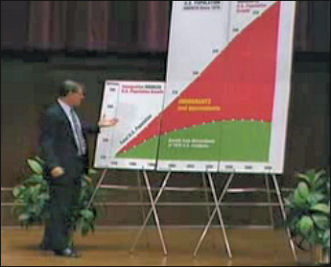 America’s Optional Future – 439 Million by Mid-Century
America’s Optional Future – 439 Million by Mid-Century
“An increase of 135 million people by 2050 is equivalent to the entire populations of Mexico and Canada moving here”
From NumbersUSA
Dr. Steven Camarota, Research Director at the Center for Immigration Studies, published an op-ed in yesterday’s Washington Post that discusses the ramifications of adding 135 million people to the U.S. population in just 42 years, something the Census Bureau’s projections say will occur unless our immigration policies change. He also stressed that the American people must decide if they want a much more densely settled country, because this outcome is not a foregone conclusion.
This projected 44 percent increase by 2050 is a direct result of U.S. immigration policy, which currently allows about one million people annually to legally take up residence in the country. This can be changed, however, if the American people pressure their Members of Congress to do so. After all, it was public pressure that forced the Bush Administration to step up immigration enforcement activity after six years of seeming indifference.
This dramatic growth would affect many issues of concern to Americans (e.g., the environment, traffic, congestion, sprawl and the loss of open spaces) and have profound implications for our quality of life. It also would have significant implications for the size and scope of government. Dr. Camarota estimates that infrastructure impacts alone would swell the size of government because the United States would need to build and pay for 36,000 schools, develop enough land to accommodate 52 million new housing units, construct enough roads to handle 106 million more vehicles, and make many other accommodations for a population this size.
Dr. Camarota downplays the overall economic benefit of immigration on this scale, citing research that shows increased economic activity in the receiving society almost entirely benefits the immigrants themselves in the form of wages and benefits. Moreover, the small benefits that do accrue to the native-born population are entirely erased by the fiscal drain immigrant households impose on taxpayers and the downward pressures high levels of immigration place on the wages of less educated, poorer workers.
While immigrants clearly do benefit by coming here, it is nonsensical to argue that the U.S. needs to maintain high levels of immigration as a way to lift up the world’s poor. While current immigration policy is causing enormous increases in the U.S. population, it diverts only a tiny fraction of the people who are living in poverty elsewhere (1.4 billion people, according to the World Bank). A better policy position would be to offer more help to poor people in their countries through trade policies and development assistance.
Dr. Camarota concluded the op-ed by noting the United States may decide to continue to allow the settlement of 1 million legal immigrants each year, and to look the other way while 500,000-plus people cross our borders illegally or overstay their visas, but such a policy choice is not preordained, just one of many the American people can tell their elected representatives to consider.
Reference:
How Many Americans? By Steven A. Camarota



